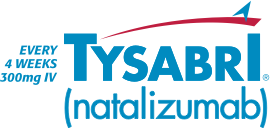1. Multiple sclerosis (MS) pathogenesis
MALE VOICEOVER: Multiple sclerosis, or MS, is an autoimmune disorder of the central nervous system, or CNS. It is characterized by inflammation, demyelination, and axonal loss. MS lesions are believed to occur when activated immune cells cross the blood-brain barrier into the CNS. Leukocytes such as T cells are immune cells involved in MS pathogenesis. In MS, T cells become activated in the periphery and migrate across the blood-brain barrier. Once inside the CNS, T cells can release cytokines and recruit other immune cells to create an inflammatory environment that is thought to lead to the destruction of myelin and axonal damage.
2. TYSABRI MOA
MALE VOICEOVER: TYSABRI, or natalizumab, indicated for the treatment of patients with relapsing forms of MS, is a monoclonal antibody that targets the alpha4-subunit of alpha4 beta1 integrins. Expressed on the surfaces of all leukocytes except neutrophils, alpha4-integrins bind to receptors on vascular endothelial cells, such as vascular cell adhesion molecule 1, or VCAM1. This interaction may facilitate the endothelial adhesion of leukocytes such as T cells and their migration across the blood-brain barrier. One of the ways in which TYSABRI may exert its effect is by binding to the alpha4-subunit of the alpha4 beta1 integrin on all leukocytes except neutrophils and blocking its interaction with adhesion molecules, including VCAM1 on the vascular endothelium. This may prevent the migration of leukocytes across the blood-brain barrier, inhibiting further recruitment and inflammatory activity of activated immune cells.
In vitro, TYSABRI may also suppress ongoing inflammation by inhibiting interactions between alpha4-integrins on leukocytes and ligands such as osteopontin and an alternatively spliced domain of fibronectin connecting segment 1 CS-1.
In vivo, TYSABRI may further act to inhibit the interaction of alpha4-expressing leukocytes with their ligands in the extracellular matrix and on parenchymal cells, thereby inhibiting further recruitment and inflammatory activity of activated immune cells.
In summary, TYSABRI may address the inflammation characteristic of MS by blocking the molecular interaction of alpha4 beta1 integrin expressed by inflammatory cells with VCAM1 on vascular endothelial cells and with CS-1 and/or osteopontin expressed by parenchymal cells in the brain.
[ISI present in video and available below.]
